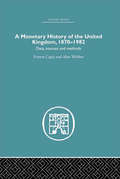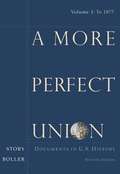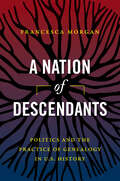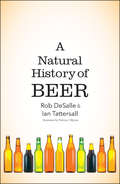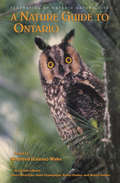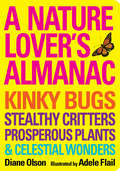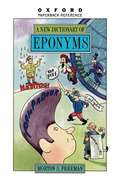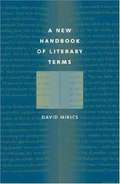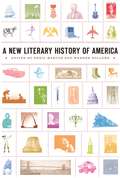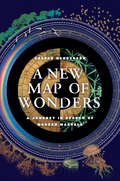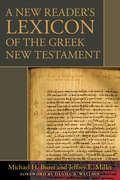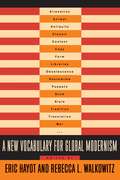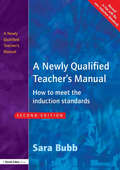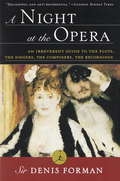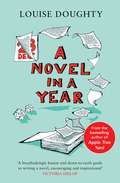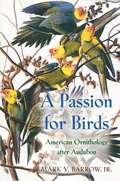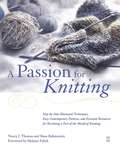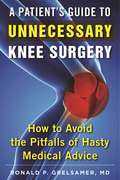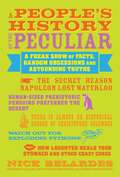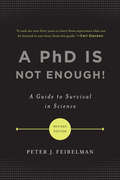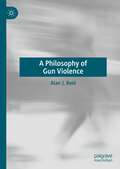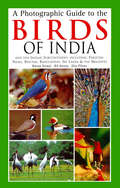- Table View
- List View
A Monetary History of the United Kingdom: 1870-1982
by Forrest Capie Alan WebberThis book is the culmination of a major research programme on the monetary history of the United Kingdom. This volume contains monetary series ranging from detailed balance sheet material to monetary aggregates such as M3 and are in monthly, quarterly and annual form. The data are drawn mostly from primary sources in the early part of the period and from more accessible published sources for more recent years. Critiques of existing series are given and assessments of the value of different sources are provided. The user should be able to build his/her own series from the basic constituents given here. This sources and assessment of data should be an essential reference to economic historians and applied economists with an interest and use to the students of money and banking and to monetary economists of other countries. This classic book was first published in 1985.
A More Perfect Union
by Paul F. Boller Ronald StoryThis reader provides a wealth of political and diplomatic primary source documents, many selections illustrated with photographs. Influential and famous readings include the Gettysburg Address, Earl Warren's opinion in Brown v. Board of Education of Topeka, and the writings of Upton Sinclair. Headnotes place the document in historical context and Questions to Consider get students thinking. The Seventh Edition includes new readings from social, economic, and cultural history; a greater diversity of voices; and nine new chapters.
A Nation of Descendants: Politics and the Practice of Genealogy in U.S. History
by Francesca MorganFrom family trees written in early American bibles to birther conspiracy theories, genealogy has always mattered in the United States, whether for taking stock of kin when organizing a family reunion or drawing on membership—by blood or other means—to claim rights to land, inheritances, and more. And since the advent of DNA kits that purportedly trace genealogical relations through genetics, millions of people have used them to learn about their medical histories, biological parentage, and ethnic background. A Nation of Descendants traces Americans' fascination with tracking family lineage through three centuries. Francesca Morgan examines how specific groups throughout history grappled with finding and recording their forebears, focusing on Anglo-American white, Mormon, African American, Jewish, and Native American people. Morgan also describes how individuals and researchers use genealogy for personal and scholarly purposes, and she explores how local businesspeople, companies like Ancestry.com, and Henry Louis Gates Jr.'s Finding Your Roots series powered the commercialization and commodification of genealogy.
A Natural History of Beer
by Ian Tattersall Rob DeSalleA celebration of beer—its science, its history, and its impact on human culture What can beer teach us about biology, history, and the natural world? From ancient Mesopotamian fermentation practices to the resurgent American craft brewery, Rob DeSalle and Ian Tattersall peruse the historical record and traverse the globe for engaging and often surprising stories about beer. They explain how we came to drink beer, what ingredients combine to give beers their distinctive flavors, how beer’s chemistry works at the molecular level, and how various societies have regulated the production and consumption of beer. Drawing from such diverse subject areas as animal behavior, ecology, history, archaeology, chemistry, sociology, law, genetics, physiology, neurobiology, and more, DeSalle and Tattersall entertain and inform with their engaging stories of beer throughout human history and the science behind it all. Readers are invited to grab a beer and explore the fascinating history of its creation.
A Nature Guide to Ontario
by Winifred WakeFrom Hudson Bay to Pelee Island, from Rainy River to the Quebec border, Ontario offers a rich variety of experiences for nature-lovers of all ages and interests. A Nature Guide to Ontario showcases more than six hundred of the best sites for viewing the many forms of plant and animal life found across the province. All sites are open to the general public, most are easily accessible, and a surprising number are located in or near the province's biggest cities.The book is divided into seven regions, and sites are listed under county, district, or municipality. Entries contain instructions on how to reach sites, descriptions of the major landscape and habitat features, information about typical as well as important or unusual animals and plants to be found at the site, and an address to contact for more information. Introductory chapters give an overview of Ontario's natural history and its rich and diverse plant and animal life. The book also discusses environmental concerns, offers tips on how to get the most out of an outing, and lists the 'top ten' nature sites in Ontario. There are lists of useful addresses and references, a site index, and an extensive glossary.This volume is a project of the Federation of Ontario Naturalists, whose affiliates and individual members have contributed to the book. A Nature Guide to Ontario, an invaluable reference for all who want to experience and enjoy the best of Ontario's natural areas and wildernesses.
A Nature Lover's Almanac: Kinky Bugs, Stealthy Critters, Prosperous Plants & Celestial Wonders
by Diane OlsonA treasury of nature facts and trivia for every season: &“Get ready to be amazed, delighted, and enlightened.&”—Chip Ward, author of Canaries on the Rim: Living Downwind in the West Did you know that:We all have follicle mites living on our faces?In India, the humble pigeon is a symbol of lust?Jumping spiders sometimes watch TV with you?Healthy garden soil has the same characteristics as a good chocolate cake?The North Pole rarely points north?The caterpillar of the silver-spotted skipper blasts its frass (poop) five feet outside its nest? This collection of fascinating but little-known facts of nature will connect you with the rhythms of the universe even if you live far from the wild—and enlighten you every day of the year. Also included are good tips for gardeners as well as a rundown of what constellations you can see in the night sky each month.
A New Dictionary of Eponyms
by Morton S. FreemanCreated about a century ago, the term eponym is itself a coinage from two Greek words, epi, "on" or "upon," and onama, "a name." But its broadened meaning, as dictionaries set it out, refers to a word derived from a proper name. For instance, Salisbury steak--a popular diner menu item created from common hamburger and dressed up with brown gravy to make it more appealing--is named for James H. Salisbury, an English physician who promoted a diet of ground beef. A Dictionary of Eponyms explores the origins of hundreds of these everyday words from Argyle socks to zeppelins. Written in an entertaining and anecdotal style, and with a foreword by Edwin Newman, the book includes a brief biography of the individual whose name became associated with an item or concept as well as information on how and when the name entered the language. If you've ever wondered just where terms like cardigan sweater, pamphlet, and robot come from, Morton Freeman does more than simply define them--he brings them to life.
A New Handbook of Literary Terms
by David MikicsA New Handbook of Literary Terms offers a lively, informative guide to words and concepts that every student of literature needs to know. Mikics's definitions are essayistic, witty, learned, and always a pleasure to read. They sketch the derivation and history of each term, including especially lucid explanations of verse forms and providing a firm sense of literary periods and movements from classicism to postmodernism. The Handbook also supplies a helpful map to the intricate and at times confusing terrain of literary theory at the beginning of the twenty-first century: the author has designated a series of terms, from New Criticism to queer theory, that serves as a concise but thorough introduction to recent developments in literary study. Mikics's Handbook is ideal for classroom use at all levels, from freshman to graduate. Instructors can assign individual entries, many of which are well-shaped essays in their own right. Useful bibliographical suggestions are given at the end of most entries. The Handbook's enjoyable style and thoughtful perspective will encourage students to browse and learn more. Every reader of literature will want to own this compact, delightfully written guide.
A New History of French Literature
by Barbara Johnson R. Howard Bloch Peter Brooks Nancy K. Miller Joan DeJean Nancy J. Vickers Denis Hollier Philip E. Lewis François RigolotDesigned for the general reader, this splendid introduction to French literature from 842 A.D.—the date of the earliest surviving document in any Romance language—to the present decade is the most compact and imaginative single-volume guide available in English to the French literary tradition. In fact, no comparable work exists in either language. It is not the customary inventory of authors and titles but rather a collection of wide-angled views of historical and cultural phenomena. It sets before us writers, public figures, criminals, saints, and monarchs, as well as religious, cultural, and social revolutions. It gives us books, paintings, public monuments, even TV shows. Written by 164 American and European specialists, the essays are introduced by date and arranged in chronological order, but here ends the book’s resemblance to the usual history of literature. Each date is followed by a headline evoking an event that indicates the chronological point of departure. Usually the event is literary—the publication of an original work, a journal, a translation, the first performance of a play, the death of an author—but some events are literary only in terms of their repercussions and resonances. Essays devoted to a genre exist alongside essays devoted to one book, institutions are presented side by side with literary movements, and large surveys appear next to detailed discussions of specific landmarks. No article is limited to the “life and works” of a single author. Proust, for example, appears through various lenses: fleetingly, in 1701, apropos of Antoine Galland’s translation of The Thousand and One Nights; in 1898, in connection with the Dreyfus Affair; in 1905, on the occasion of the law on the separation of church and state; in 1911, in relation to Gide and their different treatments of homosexuality; and at his death in 1922. Without attempting to cover every author, work, and cultural development since the Serments de Strasbourg in 842, this history succeeds in being both informative and critical about the more than 1,000 years it describes. The contributors offer us a chance to appreciate not only French culture but also the major critical positions in literary studies today. A New History of French Literature will be essential reading for all engaged in the study of French culture and for all who are interested in it. It is an authoritative, lively, and readable volume.
A New Literary History of America (Harvard University Press Reference Library)
by Werner Sollors Greil MarcusAmerica is a nation making itself up as it goes along—a story of discovery and invention unfolding in speeches and images, letters and poetry, unprecedented feats of scholarship and imagination. In these myriad, multiform, endlessly changing expressions of the American experience, the authors and editors of this volume find a new American history.In more than two hundred original essays, A New Literary History of America brings together the nation’s many voices. From the first conception of a New World in the sixteenth century to the latest re-envisioning of that world in cartoons, television, science fiction, and hip hop, the book gives us a new, kaleidoscopic view of what “Made in America” means. Literature, music, film, art, history, science, philosophy, political rhetoric—cultural creations of every kind appear in relation to each other, and to the time and place that give them shape.The meeting of minds is extraordinary as T. J. Clark writes on Jackson Pollock, Paul Muldoon on Carl Sandburg, Camille Paglia on Tennessee Williams, Sarah Vowell on Grant Wood’s American Gothic, Walter Mosley on hard-boiled detective fiction, Jonathan Lethem on Thomas Edison, Gerald Early on Tarzan, Bharati Mukherjee on The Scarlet Letter, Gish Jen on Catcher in the Rye, and Ishmael Reed on Huckleberry Finn. From Anne Bradstreet and John Winthrop to Philip Roth and Toni Morrison, from Alexander Graham Bell and Stephen Foster to Alcoholics Anonymous, Life, Chuck Berry, Alfred Hitchcock, and Ronald Reagan, this is America singing, celebrating itself, and becoming something altogether different, plural, singular, new.
A New Map of Wonders: A Journey in Search of Modern Marvels
by Caspar Henderson“Henderson teaches us how to wonder anew with a new vision of science illuminated by a rich range of literature, philosophy, art, and music.” —Hugh Aldersey-Williams, author of Dutch LightWe live in a world that is known, every corner thoroughly explored. But has this knowledge cost us the ability to wonder? Wonder, Caspar Henderson argues, is at its most supremely valuable in just such a world because it reaffirms our humanity and gives us hope for the future. That’s the power of wonder, and that’s what we should aim to cultivate in our lives. But what are the wonders of the modern world?Henderson’s brilliant exploration borrows from the form of one of the oldest and most widely known sources of wonder: maps. Large, detailed mappae mundi invited people in medieval Europe to vividly imagine places and possibilities they had never seen before: manticores with the head of a man, the body of a lion, and the stinging tail of a scorpion; tribes of one-eyed men who fought griffins for diamonds; and fearsome Scythian warriors who drank the blood of their enemies from their skulls. A New Map of Wonders explores these and other realms of the wonderful, in different times and cultures and in the present day, taking readers from Aboriginal Australian landscapes to sacred sites in Great Britain, all the while keeping sight questions such as the cognitive basis of wonder and the relationship between wonder and science.Beautifully illustrated and written with wit and moral complexity, this sequel to The Book of Barely Imagined Beings is a fascinating account of the power of wonder and an unforgettable meditation on its importance to our future.
A New Reader's Lexicon of the Greek New Testament
by Michael H. Burer Jeffrey E. Miller"What Kubo did for the last generation, Burer and Miller's A New Reader's Lexicon will do for the next."-from the foreword by Daniel B. WallaceImproving on earlier lexical works, A New Reader's Lexicon of the Greek New Testament incorporates all words that occur fewer than fifty times in the New Testament. In canonical order, it catalogs a word's frequency in each book,in each author's writings, and in the entire New Testament. References to rare or noteworthy word usages are included, allowing the reader to quickly identify words of special significance."This lexicon . . . has overcome the noticeable shortcomings of Kubo and should well serve the person who wants to keep up their Greek by daily reading, but gets frustrated by having to spend so much time looking up words." -Gordon D. Fee Professor of New Testament Studies Regent College"A New Reader's Lexicon is a step forward for the student of Greek and is sure to be of benefit to those who teach Greek. . . . The use of A Greek-English Lexicon of the New Testament and Other Early Christian Literature (BDAG) is a great touch."-Darrell L. Bock Research Professor of New Testament Studies Dallas Theological Seminary"Very usable, exceedingly helpful, and a fine contribution to any student of the Word interested in serious reading of the Greek New Testament."-Grant Osborne Professor of the New Testament Trinity Evangelical Divinity School
A New Vocabulary for Global Modernism (Modernist Latitudes)
by Eric Hayot Rebecca L. WalkowitzBringing together leading critics and literary scholars, A New Vocabulary for Global Modernism argues for new ways of understanding the nature and development of twentieth-century literature and culture. Scholars have largely understood modernism as an American and European phenomenon. Those parameters have expanded in recent decades, but the incorporation of multiple origins and influences has often been tied to older conceptual frameworks that make it difficult to think of modernism globally. Providing alternative approaches, A New Vocabulary for Global Modernism introduces pathways through global archives and new frameworks that offer a richer, more representative set of concepts for the analysis of literary and cultural works.In separate essays each inspired by a critical term, this collection explores what happens to the foundational concepts of modernism and the methods we bring to modernist studies when we approach the field as a global phenomenon. Their work transforms the intellectual paradigms we have long associated with modernism, such as tradition, antiquity, style, and translation. New paradigms, such as context, slum, copy, pantomime, and puppets emerge as the archive extends beyond its European center. In bringing together and reexamining the familiar as well as the emergent, the contributors to this volume offer an invaluable and original approach to studying the intersection of world literature and modernist studies.
A Newly Qualified Teacher's Manual: How to Meet the Induction Standards
by Sara BubbBased on over two years experience of running courses and researching provision for NQTs, the book looks at what NQTs are entitled to and how to make the most of it
A Night at the Opera: An Irreverent Guide to The Plots, The Singers, The Composers, The Recordings
by Denis FormanThis slightly irreverent guide to opera summarizes the plots of 17 of the world's great operas, including Aida, La Boheme, and Carmen, and describes their characters, artists, and composers.
A Novel in a Year
by Louise DoughtyFor the many thousands of aspiring novelists looking for no-nonsense advice, a unique, step-by-step guide to How to Write a Novel in a Year from the celebrated novelist Louise Doughty
A Passion for Birds: American Ornithology after Audubon
by Mark BarrowIn the decades following the Civil War--as industrialization, urbanization, and economic expansion increasingly reshaped the landscape--many Americans began seeking adventure and aesthetic gratification through avian pursuits. By the turn of the century, hundreds of thousands of middle-and upper-class devotees were rushing to join Audubon societies, purchase field guides, and keep records of the species they encountered in the wild. Mark Barrow vividly reconstructs this story not only through the experiences of birdwatchers, collectors, conservationists, and taxidermists, but also through those of a relatively new breed of bird enthusiast: the technically oriented ornithologist. In exploring how ornithologists struggled to forge a discipline and profession amidst an explosion of popular interest in natural history, A Passion for Birds provides the first book-length history of American ornithology from the death of John James Audubon to the Second World War. Barrow shows how efforts to form a scientific community distinct from popular birders met with only partial success. The founding of the American Ornithologists' Union in 1883 and the subsequent expansion of formal educational and employment opportunities in ornithology marked important milestones in this campaign. Yet by the middle of the twentieth century, when ornithology had finally achieved the status of a modern profession, its practitioners remained dependent on the services of birdwatchers and other amateur enthusiasts. Environmental issues also loom large in Barrow's account as he traces areas of both cooperation and conflict between ornithologists and wildlife conservationists. Recounting a colorful story based on the interactions among a wide variety of bird-lovers, this book will interest historians of science, environmental historians, ornithologists, birdwatchers, and anyone curious about the historical roots of today's birding boom.
A Passion for Knitting: Step-by-Step Illustrated Techniques, Easy Contemporary Patterns, and Essential Resources for Becoming Part of the World of Knitting
by Nancy Thomas Ilana RabinowitzThe World of Knitting Right at Your FingertipsMore than a how-to book, A Passion for Knitting goes beyond teaching the craft and introduces readers to the culture of knitting. In Part I, you'll find fully illustrated instructions for learning stitches and mastering technique, presented with unprecedented clarity. They're so simple that you really can learn without a teacher. With this book in hand -- and no prior experience -- you will be able to knit a gorgeous sweater, scarf, or throw.Next, Part II welcomes new knitters to the worldwide knitting community, exploring the myriad benefits this popular craft has to offer. This section, unique among all other guides, invites readers toTap into the power of knitting as a means of reducing stress and expressing creativityMeet the design "gurus" and other stars of the knitting worldDiscover opportunities for fellowship and networking with other knitters in clubs, conventions, and unique cultural fiber tours to countries ranging from England to PeruUse their knitting skills to meaningfully support charitiesLearn about the fashion trends in knitting from Trisha Malcolm, editor in chief of Vogue Knitting
A Patient's Guide to Heart Rhythm Problems (A Johns Hopkins Press Health Book)
by Todd J. CohenA Library Journal Best Consumer Health Book of 2010Heart rhythm problems can be a matter of life or death. In this easy-to-read guide, Dr. Todd Cohen provides comprehensive information to help people with heart rhythm problems (arrhythmias) get an accurate diagnosis and appropriate treatment. Dr. Cohen tells readers what they need to know about palpitations, rapid heart rhythms (tachycardias), slow heart rhythms (bradycardias), cardiac arrest, and other conditions related to irregular heartbeats.With the goal of informing and empowering heart patients, Dr. Cohen describes the heart's basic function, the various conditions associated with arrhythmia, and recommended courses of treatment. He discusses such procedures as tilt table testing, electrophysiology studies, catheter ablation, and device implantation (including cardiac monitors, pacemakers, defibrillators, and biventricular devices); explains the essentials of CPR and the use of Automatic External Defibrillators (AEDs); and presents the latest guidelines from the American College of Cardiology, the American Heart Association, and the Heart Rhythm Society. A Patient's Guide to Heart Rhythm Problems will help readers understand• how the heart works and what can go wrong• the tests and other diagnostic procedures they may undergo• how their doctor reaches a diagnosis• what their diagnosis means• how their doctor might treat the problem• when medication alone is sufficient treatment• when pacemaker, defibrillator, or biventricular therapy is appropriate• how to get the best possible medical care—in and out of the hospitalEndorsed by the Sudden Cardiac Arrest Association, this essential resource features tables highlighting key information, as well as patient narratives that provide personal insight into arrhythmia tests, treatments, and technologies.
A Patient's Guide to Unnecessary Knee Surgery: How to Avoid the Pitfalls of Hasty Medical Advice
by Ronald P. GrelsamerEvery year millions of Americas are told by an orthopedic surgeon that the only way to successfully get rid of their knee pain is to undergo some form of knee surgery. But so many of these procedures could have been avoided if the patient was fully informed regarding all the intricacies of his or her condition.In A Patient’s Guide to Unnecessary Knee Surgery, respected orthopedic surgeon Ronald P. Grelsamer intricately and accessibly conveys all the information regarding the knee and surrounding areas that any person suffering from knee pain would ever need to know in order to make an informed decision about treatment for his or her condition. Within this guide, you’ll find chapters on pertinent topics such as: Reasons behind some of the leading causes of knee pain Tips on how to understand the results of an MRI Exercises to boost your knee health Advice on how to find the best doctor for your needs And ten other areas of knee-related healthSo if you’re suffering from knee pain, make sure to you grab A Patient’s Guide to Unnecessary Knee Surgery before you decide to undergo surgery.
A People's History of the Peculiar
by Caroline Leavitt Nick BelardesDid you know that Thomas Jefferson's grandson was an ax murderer? Do you delight knowing that some dinosaurs were as teeny tiny as hens? Wonder what it's like to live in Hell Town at the End of the World? How about an ailment so surreal it's named after Alice in Wonderland? In A People's History of the Peculiar, historian Nick Belardes has dug into the raw source material found in historical archives, scientific studies, and libraries the world over to find facts, lists, definitions, and astonishing information guaranteed to provide readers with the best cocktail conversation topics for many years to come! Also found here are first-person interviews with people who can explain the unexplained, from the permanently puzzling Mothman conspiracy to secret Star Wars Jedi religious cults and the charmingly eccentric reason why British aerospace engineers sent teddy bears floating out into space. These real-world facts are outlandish enough to sharpen the brain and occupy readers' minds for hours of entertainment.
A People's History of the Peculiar: A Freak Show of Facts, Random Obsessions and Astounding Truths
by Nick BelardesDid you know that Thomas Jefferson's grandson was an ax murderer? Do you delight knowing that some dinosaurs were as teeny tiny as hens? Wonder what it's like to live in Hell Town at the End of the World? How about an ailment so surreal it's named after Alice in Wonderland? In A People's History of the Peculiar, historian Nick Belardes has dug into the raw source material found in historical archives, scientific studies, and libraries the world over to find facts, lists, definitions, and astonishing information guaranteed to provide readers with the best cocktail conversation topics for many years to come! Also found here are first-person interviews with people who can explain the unexplained, from the permanently puzzling Mothman conspiracy to secret Star Wars Jedi religious cults and the charmingly eccentric reason why British aerospace engineers sent teddy bears floating out into space. These real-world facts are outlandish enough to sharpen the brain and occupy readers' minds for hours of entertainment.
A PhD Is Not Enough!: A Guide to Survival in Science
by Peter J. FeibelmanDespite your graduate education, brainpower, and technical prowess, your career in scientific research is far from assured. Permanent positions are scarce, science survival is rarely part of formal graduate training, and a good mentor is hard to find. InA Ph. D. Is Not Enough!, physicist Peter J. Feibelman lays out a rational path to a fulfilling long-term research career. He offers sound advice on selecting a thesis or postdoctoral adviser; choosing among research jobs in academia, government laboratories, and industry; preparing for an employment interview; and defining a research program. The guidance offered inA Ph. D. Is Not Enough!will help you make your oral presentations more effective, your journal articles more compelling, and your grant proposals more successful. A classic guide for recent and soon-to-be graduates,A Ph. D. Is Not Enough!remains required reading for anyone on the threshold of a career in science. This new edition includes two new chapters and is revised and updated throughout to reflect how the revolution in electronic communication has transformed the field.
A Philosophy of Gun Violence
by Alan J. ReidThis book uses a philosophy of technology to demonstrate that guns are predisposed for an intentional use, making them inherently non-neutral artifacts. This argument rejects the often-cited value neutral thesis and instrumentalist view that “guns don’t kill people; people kill people”, and instead, explains the lethality of the gun through the lenses of affordance theory, behavioral design, and choice architecture. Ultimately, this book proposes an ethical and value-sensitive model for gun reform, which embodies the perspective of French philosopher Bruno Latour, who said, “You are different with a gun in your hand; the gun is different with you holding it.”
A Photographic Guide to the BIRDS OF INDIA
by Bikram Grewal Bill Harvey Otto PfisterThis guide covers 800 species found in India. Each species description is illustrated with a photograph and distribution map, making this a quick-reference guide in a pocketable format. Introductory sections include general information, such as the biogeography of the region covered.
